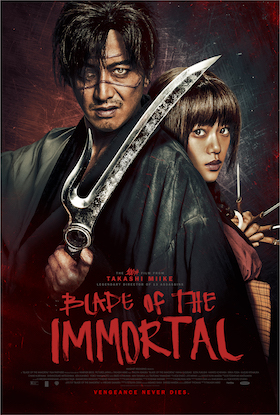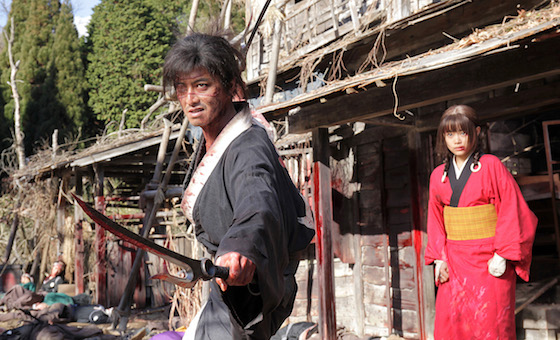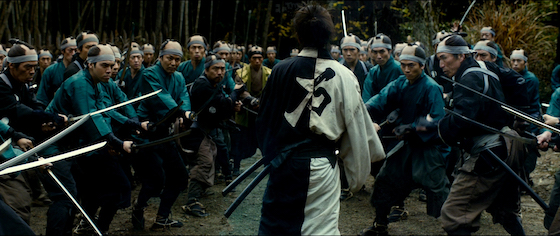At once a blood-soaked, limb-chopping tribute to samurai cinema and magna literature, Blade of the Immortal (opening today at Screenland at Tapcade) is also something else: a self-aware synthesis of revenge culture, outsiders, and the post-modern notion of “hero.” Ostensibly the story of an immortal samurai finding redemption through the protection of a young girl, the film is also a tribute to True Grit, X-Men, and just enough Sanjuro to anchor it to its Kurosawa roots. And while it runs a bit long, and suffers from a couple of sub-plots that it might have done better without, the overall narrative is strong.
The film opens with Manji (Takuya Kimura) slicing his way through a gaggle of samurai retainers. Set in the middle of the Tokugawa Shogunate period (so the 1750s or thereabouts), Manji is himself a retainer that has turned against his lord, and thus is a wanted man. Although he’s able to carve up roughly one hundred men all by himself, he’s not able to save his younger sister from the assassins that are after him, and is on the verge of death when a mysterious witch finds him and grants him immortality via some “blood worms.”
Kind of like a samurai version of Wolverine, Manji can be injured, and does feel pain, yet the blood worms inside of him heal any wounds almost instantly. This includes full amputations, which can be patched up so long as the missing limb is located, and Manji’s body is given a bit of time to recuperate. This plot point is utilized splendidly during the numerous battles Manji engages in throughout Blade of the Immortal, which see him losing more fights than he wins. Hero though he may be, Manji eschews typical samurai tropes by NOT being the deadliest son of a bitch on the block, which hardly matters in a film where the hero can land a death blow and walk away after being skewered.
Old, surly, and missing an eye, Manji is this film’s Rooster Cogburn to Rin (Hana Sugisaki), an adolescent girl seeking revenge. Early in the first act, Rin watches as her father and mother are murdered and raped (respectively) by the leader of a rogue school of swordsmen called the Itto-ryu. Consumed with grief, and hungry for vengeance, Rin comes across the same crone who blessed (cursed?) Manji with his immortality, who directs her to the rogue samurai. Now fifty years into his eternal life, Manji is at first reluctant to help, but is won over by Rin’s story and her shocking resemblance to the sister he lost.
From here, things proceed about as one would expect, with Rin directing Manji to the men who killed her family one at a time, leading to a series of duels that are as spectacular as they are gruesome. This is director Takashi Miike’s one hundredth feature, and the comfort he has behind the camera, staging and shooting these frantic and tidy fight scenes, is evident. Whether it is one vs. one or one vs. one hundred doesn’t matter: the action feels real and appropriate to the moment. No, seriously, Miike can make one guy taking on eight dozen swordsmen seem borderline realistic, and doesn’t flinch with his blocking and cuts to give the viewer a fully realized fight scene.
Fans of Miike’s 13 Assassins are familiar with this particular skill, along with Miike’s ability to juxtapose ultraviolence on steroids with a canny backhanded sense of humor (see his Ichi the Killer for more of that). Yet Blade of the Immortal isn’t just an excuse to adapt a popular, violent magna series to the screen. Miike has a lot to say about the subjective nature of truth and honor, and what it means to be the hero of one’s own personal narrative. The leader of the Itto-ryu, the chilling and deadly Anotsu (Sota Fukushi), isn’t just killing for the hell of it: he’s looking to break down the rigid caste system built into Edo’s sword schools. Sure, he’s a murderous prick, but in his mind, he’s striving for a higher and greater good.
Stylistically, Miike is also saying something, here, for the members of the Itto-ryu reflect a mélange of hair and clothing looks that span the gamut from 18th century period-appropriate to 1980s punk. Much like Anotsu, who desires to both destroy the rigid sword school structure, but also become a part of it, Miike seems to want to break down the aesthetic of samurai cinema whilst crafting something that is clearly a love letter to it. It’s not enough for Rin to just get her revenge, she wants it to be honorable and just; this desire runs up hard against the reality of her situation, however, for in the process of avenging her two parents, she’s condemning hundreds more to violent deaths.
This is an irony that doesn’t go unnoticed or unremarked upon, and it is one of the strongest elements to the picture. That said, at nearly two and a half hours long, there’s some fat that can be cut from Blade of the Immortal. There are numerous B-plots about members of Anotsu’s squad that are fun, yet unnecessary, and a group of characters that are introduced 90 minutes into the movie that only serve to raise stakes already pushing through the ceiling. It all works, but considering some of the rushed aspects of the second act, one can’t help but feel they might have been better served on the cutting room floor (or in a sequel that would have allowed earlier developments to breathe more).
Opening today, Blade of the Immortal is a fun, raucous, bloody love letter to samurai cinema, as well as an introspective examination of that genre’s most popular tropes. Come for the stabbings, stay for the ponderous postmodern critiques: it’s all delicious.









Comments on this entry are closed.